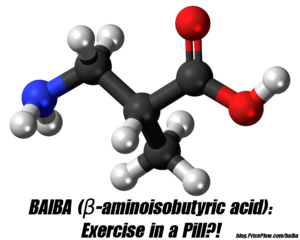
This amino acid has a similar structure to beta alanine and taurine, and is created naturally when you exercise. But can ingesting it make your body kick into "exercise mode" without lifting a finger?!
We're always on the lookout for supplement ingredients that could be the "Next Big Thing", and it's very possible we just found one for dieters.
Its name is BAIBA (pronounced "BAY-buh"), and it may be able to mimic certain fat-burning processes that occur in your body when exercising - even when you're not working out!
Of course, we never suggest avoiding exercise, but research published in 2014 definitely got our attention, which is why we originally wrote this article in 2015. Four years later, we finally found a trustworthy ingredient supplier in NNB Nutrition's MitoBurn, allowing us to pursue more research.
TL;DR
- BAIBA (or β-aminoisobutyric acid) is an "amino acid" generated during exercise.
- It is involved in several healthy processes, such as the thermogenic browning of white fat and exercise-based prevention of bone and muscle loss.
- When supplemented, it is pro-ketogenic and increases fatty acid oxidation in the liver while protecting against fat gain and improving glucose tolerance in mice. (See the BAIBA Research section)
- There are two isomers of BAIBA, L-BAIBA and D-BAIBA, research shows L-BAIBA is superior for supplementation because it leads to more positive metabolic health outcomes.
- The preferred BAIBA Supplement ingredient is MitoBurn by NNB Nutrition. (See the BAIBA Supplements section)
-
Interested in trying NNB Nutrition's MitoBurn for your brand's formulas? Contact us and we'll arrange a sample for you or email NNB Nutrition directly at info@nnbnutrition.com!
Suggested doses are 250-500mg, 1-2 times per day. (See the BAIBA Dosage section)
-
- There are no currently known side effects at the above doses, but because it is a new ingredient with limited human research, caution is suggested.
- In 2019, safety data was conducted on mice and showed L-BAIBA's LD50 (lethal dose for 50% of animals) was well over 2,000mg/kg of body weight, which means we're very comfortable with the suggested dose.
- Under DSHEA, BAIBA is by definition a dietary supplement since it covers several sections.
No statements on this page are approved by the FDA and you should seek a doctor's approval before beginning any new supplement or dietary program.
This ingredient is incredibly interesting, especially to aggressive dieters, but is definitely not for the conservative or cautious user -- at least until more human-based research is published.
This article is science-intense, so get ready:
What is BAIBA?
BAIBA, or β-aminoisobutyric acid, is an amino acid generated during exercise (an "exercise-induced muscle factor") that is not naturally found in the genetic code of any organism -- it's formed when either thymine or valine are broken down.[1]
This means that BAIBA, while an amino acid, is not a building block for proteins but rather is used as a signaling molecule within the body. Because of this, consuming it will not contribute to the development of muscle mass like traditional essential amino acids (often used for recovery during or after a workout), but it may hold promise for fat-loss - and weight loss.
-
L-BAIBA vs. D/R-BAIBA: Which Form is Best?
There are two forms of BAIBA discussed in the literature: L-BAIBA (S-BAIBA) and D-BAIBA (R-BAIBA).[2,3] These two types are also referred to as enantiomers, which means they're a pair of molecules that are mirror images of each other. You could also think of them as "right-handed" and "left-handed" notations because they are similar to your left and right hands - similar structure, similar components, but do not "map" on top of each other. Most researchers suggest that D-BAIBA is the most prevalent enantiomer in urine,[2,4] but newer research confirms that L-BAIBA is most major in plasma.[5]
-
BAIBA’s Connection to Valine and Thymine
The two forms of BAIBA are also linked to two amino acids, thymine and valine. L-BAIBA is formed from the mitochondrial reactions of L-valine, a branched-chain amino acid (BCAA), whereas D-BAIBA is formed from thymine metabolism.[6]
Many athletes already take BCAA supplements, which contains a decent amount of valine. There are a total of three amino acids that collectively make up the BCAA group: Leucine, Isoleucine, and Valine. The first two are widely known for their ability to initiate muscle protein synthesis. However, in the past the importance of valine was not very well understood.
Valine: The underrated BCAA due to its metabolism to BAIBA
Thanks to the latest research on BAIBA, we're starting to get a better understanding of just how important valine is. These three amino acids are also part of the nine essential amino acids humans must consume, because the body cannot synthesize them.[7] Therefore, it is crucial to get these from our diets.
-
Why L-BAIBA is Superior to R-BAIBA
Given that L-BAIBA comes from valine and R-BAIBA comes from thymine, is one really biologically "better" than the other when taken as a supplement?
Research shows L-BAIBA is the form that increases during muscle contractions due to the oxidation of L-valine.[8] Because of this phenomenon, L-BAIBA is also referred to as an "exercise-induced muscle factor". Since L-BAIBA comes from valine metabolism, this growing body of evidence shines a light on the importance of valine supplementation (and overall complete protein intake) for physically active people or those in a calorie deficit. Although there still may be some benefits to D-BAIBA, the one that is showing the most positive metabolic health effects is L-BAIBA.[6]
Next, we investigate BAIBAs effectiveness as a fat-burning / weight-loss product and its potential effectiveness at enhancing performance.
-
What is BAIBA used for?
As you know, the increasing obesity rate in the western world has given rise to a host of metabolic conditions that number in the top ten leading causes of death in the world.[9] As such, researchers from around the globe have been searching frantically for ways to combat obesity and reduce the impact of these metabolic conditions.
One of these research strategies is targeted at the development of anti-obesity compounds that work to increase fat mobilization and oxidation (freeing up stored fat then burning it for energy) that are also relatively side effect free and effective.
It is in this context -- severe weight disorders -- that BAIBA is being researched.[1,9,10]
-
Discovery of BAIBA
BAIBA is also known as β-aminoisobutyric acid, 3-Aminoisobutyric acid, 3-amino-2-methylpropanoate, 3-amino-2-methylpropanoic acid, and 3-amino-isobutanoate
In a large ongoing study known as the Framingham Heart Study , the relationship between BAIBA and metabolic risk factors humans came to light.[1] Researchers noted that study participants who were put on an exercise program had higher levels of BAIBA, and that higher levels of naturally occurring BAIBA seemed to coincide with lower levels of circulating glucose, triglycerides and cholesterol.[1]
Some call it “Exercise in a pill”??
The findings were so substantial that they even made their way into online news sites that claimed BAIBA may be 'exercise in pill form' -- if BAIBA could be synthesized and placed in a capsule.[11]
The idea being that BAIBA could either be used in conjunction with exercise to enhance its effects, or instead of, to still gain some of the metabolic benefits of exercise without actually lifting a finger – though it remains to be seen if the reality matches the media's hyperbole.
Watch our BAIBA video with Shawn Wells
Mike brought industry guru Shawn Wells on to discuss BAIBA - check out the video below if you'd rather listen than read!
Now let's get to the fun part:
BAIBA’s role in the body
BAIBA mimics the role of exercise through a few interrelated pathways, however, it must be emphasized that BAIBA does not augment structural changes in muscle (hypertrophy) or cause an increase in strength in any way.
Instead, BAIBA's effects are based around metabolic changes in the liver and in fatty tissue. Some of these are:
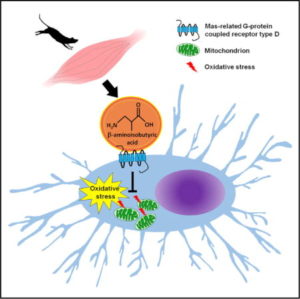
New research has shown that BAIBA may protect from disuse-based bone loss thanks to it preventing osteocyte cell death that would have been induced by reactive oxygen species (ROS).[8]
- Changes the characteristics of energy storing white adipose tissue into energy burning brown-like adipose tissue via PPAR alpha.[1,10]
- Increases liver (hepatic) beta oxidation (fat burning) though a PPARa mediated mechanism.
- Protect against fat gain in mice with partial leptin deficiency.[1,10,12]
- Increase plasma beta-hydroxybutyrate, which is the primary ketone body generated when beta-oxidizing fat (especially on a ketogenic diet)[13]
- Improve glucose tolerance and insulin sensitivity through AMP-activated protein kinase (AMPK) and PPARa[14,15]
- Prevent disuse-based bone and muscle loss through the Mas-Related G Protein-Coupled Receptor Type D (MRGPRD) to prevent the breakdown of mitochondria and cell death due to reactive oxygen species (ROS)[8]
The below diagram highlights the process by which BAIBA is increased and how it exerts its effects:
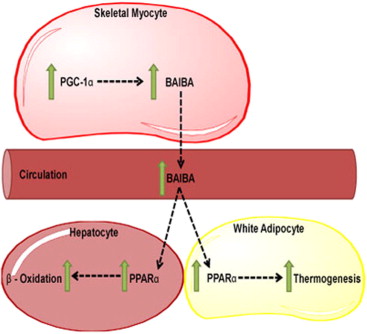
The process by which BAIBA is increased and how it exerts its effects[1]
At this point, we need to dig deeper and discuss the functions mentioned above, which will help explain how BAIBA works and how it is expressed.
PPAR alpha and PGC1 alpha
As stated above, BAIBA performs most of its roles through PPAR alpha activation, however, it is only released when another protein is expressed in muscle tissue – PGC1 alpha.[1,10,16]
PGC1 Alpha’s role
PGC 1 alpha is a protein that is increased during and after aerobic exercise. It contributes to the way our bodies respond to an exercise stimulus -- by performing the following tasks:
- increasing development of mitochondria (cell powerhouses),
- regulating blood pressure,
- regulating cholesterol, and
- by changing the composition of our fat cells.[16]
PGC1 alpha is restricted to muscle tissue so in order to exert its effects elsewhere in the body, it uses 'messenger' molecules , called myokines, such as irisin and BAIBA to do its bidding in other areas of the body.[16]
PPAR Alpha - Closer to the end game
BAIBA acts on PPARa to perform the roles of white adipose browning, increase of beta oxidation and decrease in fat creation.[1,10,17]
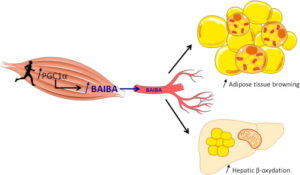
"BAIBA is released from the muscle after an exercise bout, promoting differentiation of brown adipocyte-like cells within subcutaneous fat depots and fat oxidation in the liver."[18]
In short hand, exercise increases PGC-1alpha, PGC-1alpha increases BAIBA, BAIBA increases PPAR alpha activity, and PPARa activity does a lot of the work we ultimately desire when exercising.
PPAR alpha is a major regulator of lipid metabolism in the liver, involved in the breakdown of fatty acids and increases in energy utilisation. It performs its work through increasing fatty acid transport, binding, and activation and through beta oxidation.[12,19]
Beta oxidation is the process in which fat is broken down for use as energy in the body.[12]
Next, let's take a look at the different forms of adipose in the body to see how BAIBA influences these, and why it matters.
Brown vs. White Adipose Tissue
In the body, we have two major types of adipose tissue: brown and white.[10,20].
-
White Fat: The ugly kind we all want to burn
The most predominant one is white adipose tissue, which represents the store of energy in our bodies. This form is the type we can see and grab on our bodies, which can be broken down for energy during periods of low intensity exercise and in periods of calorie deficits.
White adipose tissue also creates the hormone leptin.[10,20]
-
Brown Fat: The Energy User
Brown adipose tissue on the other hand is more of an energy spender than a saver [20]. Its role is more obvious in animals that hibernate throughout the winter and need to keep warm whilst they are in their slumber. Brown fat generates this heat through mitochondrial uncoupling (a form of thermogenesis that expends energy as heat) and allows these animals to stay warm without shivering.[20]
However, in humans, brown fat only constitutes a very small amount of the fat we carry as we mostly shiver, heat our house, or put on warmer clothes in order to warm up.[20] Brown adipose appears brown due to the increased mitochondria and enhanced blood supply.[10,20]
How BAIBA works: the 'exercise molecule' part
So when a person exercises, concentrations of BAIBA dramatically increase within both skeletal muscle and within other tissues.[1,10] BAIBA then signals for an increase in the expression of brown adipocyte-specific genes via PPAR alpha, which triggers the "browning of white fat".[1]
Brown adipose cells generates heat from fat, increasing the body's metabolism and therefore expending more calories during rest and exercise.
-
Converting to a hybrid fat with the best of both worlds
Interestingly, however, BAIBA doesn't turn white fat completely brown but instead turns it into a third type known as "beige" fat.[1,20] This adipose form has the characteristics of brown fat but exists within white fat cells, thus allowing for heat generation from within the stored fat.[20]
BAIBA also influences liver fat burning and cholesterol regulation through PPAR alpha activation: when PPAR alpha is activated, it increases the expression of lipoprotein lipase and apolipoprotein A-V, and decreases expression of apoC-III in the liver.[21,22]
These three changes allow the breakdown of triglycerides and cholesterol and the transport of fatty acids out of the liver to be either stored again or burned for energy.
Going further, PPAR alpha activation also increases hepatic apoA-I and apoA, which increases levels of the 'good' cholesterol, HDL.[21,22]
Simplified scheme of BAIBA metabolism, valine degradation, and thymine catabolism[23]
-
Partial leptin deficiency: incredibly promising for obesity
BAIBA also has the potential to limit the development of obesity in mice with partial leptin deficiency when eating a hypercaloric diet.[24] This study mimics what we might observe in humans who are eating a hypercaloric diet and have higher levels of body fat.[25]
What makes this point interesting is that leptin is created in white adipose tissue, so the more fat you have, the greater amount of leptin that is produced.[25]
The hazardous leptin negative feedback loop - can it be stopped?
Getting caught in the "Leptin Negative Feedback Loop" is one of the biggest challenges you can create for yourself. Can BAIBA supplementation help anyone break the cycle?
While this seems like a good thing given leptin signals the body that it is full, overstimulation can desensitize the leptin receptors in the brain and therefore stop this mechanism from working, creating a feeling of constant hunger in obese people as well as decreasing metabolic rate; essentially mimicking a leptin deficiency.[25,26]
The above situation is known as leptin's "negative feedback loop" and is a monumentally serious detriment to heavily overweight individuals who cannot seem to kick out of the "downward spiral" of hunger and weight gain.
In this study, BAIBA was able to curb adiposity by 27% and reduce fat mass by 40%![24]
Other BAIBA Research Studies: Various positive effects
-
A pro-ketogenic molecule
This article was originally written in 2015, just before the surge of the ketogenic diet. It turns out that it had been known since 2004 that BAIBA increases plasma levels of beta-hydroxybutyrate in mice - despite unchanged food consumption.[13]
Beta-hydroxybutyrate, or BHB, is the primary ketone body generating when beta oxidizing fat. It becomes the main fuel source for anyone who has not ingested carbohydrates recently, and is created from either dietary fat or bodyfat when fasted or in caloric deficit.
Hepatic fatty acid oxidation: clear liver fat faster?
The researchers suggested that BAIBA "increased hepatic fatty acid oxidation and ketogenesis", which becomes extremely important for dieters because many researchers (including ourselves) postulate that bodyfat won't get seriously worked off until the liver's is first cleared out.
There are several ways of doing this, such as high intensity interval training (HIIT), but many obese individuals simply cannot partake in this type of activity. Thus, any molecule that safely makes this happen faster is of immediate interest.
-
Prevention of Disuse-Based Bone and Muscle Loss
In 2018, already knowing its white fat browning and insulin sensitization capabilities, a team of researchers investigated some alternate pathways BAIBA could operate on. They connected BAIBA to the well-known ability for exercise to prevent bone loss. Their research showed that the molecule "prevents osteocyte cell death induced by reactive oxygen species (ROS)":[8]
L-BAIBA was as or more protective than estrogen or N-acetyl cysteine, signaling through the Mas-Related G Protein-Coupled Receptor Type D (MRGPRD) to prevent the breakdown of mitochondria due to ROS. BAIBA supplied in drinking water prevented bone loss and loss of muscle function in the murine hindlimb unloading model, a model of osteocyte apoptosis.[8]
While we once again always recommend regular exercise, it's simply not always possible for some individuals. Supplementing BAIBA may provide at least some (but likely not all) of the osteoprotective benefits of exercise. It's important to note that BAIBA supplementation worked best in the younger subjects when it came to bone loss prevention.
-
Improvement of glucose tolerance and insulin resistance related issues
Insulin resistance is believed by many to be central to most modern diseases. Two recent studies have shown improvements to glucose sensitivity and insulin resistance.
-
Improvements from a high-fat diet
Despite eating the most calories, the high-fat diet mice that also received BAIBA had far less weight gain and better blood glucose scores than their non-BAIBA counterparts.[14]
In the first study from 2015,[14] mice were put on a high-fat diet ("HFD": 60% energy from fat) and eventually became "glucose intolerant" due to their lack of use of glucose. Some of these mice were given BAIBA, others were not, and both of those HFD groups were compared to placebo.Treatment with BAIBA for eight weeks significantly improved HFD-induced glucose tolerance and insulin resistance, and did so in the muscle cells.[14] This could have serious implications for ketogenic dieters looking to remain metabolically flexible.
Meanwhile, it also decreased the weight gain from the high-fat diet, even though the high-fat dieting mice taking BAIBA ingested the most calories!
-
Improvements to diabetic mice
Another study published in 2016 showed that "BAIBA attenuates glucose metabolic disturbance and improves insulin resistance in STZ/HFD-induced type 2 diabetes in mice."[15]
In this study, the researchers stressed the bodies of the mice (especially the livers) through various mechanisms involving AMPK, and were able to attenuate the damage each time with BAIBA treatment.
The primary novel findings in the present study are that oral administration of BAIBA attenuates hepatic ER (endoplasmic reticulum) stress, apoptosis and glucose/lipid metabolic disturbance in type 2 diabetes.[15]
-
-
Protection against renal fibrosis in mice
Looking at the mechanisms discussed above, in 2018, a team of researchers hypothesized that BAIBA may slow kidney fibrosis by slowing the formation of fibroblasts (a common type of connective tissue) in the kidneys.[27] They tested several known pathways and gene expressions and had some seriously successful results with some of them:
"Taken together, our data provide the first demonstration that BAIBA significantly alleviated the fibrotic responses and renal functional impairment in the obstructed kidneys. Inhibition of Ang II / IL-17 / ROS signaling pathway was responsible for the role of BAIBA in attenuating renal fibrosis. BAIBA may be useful for the treatment of patients with chronic kidney diseases."[27]
Now before anyone dismisses this idea purely because it was established in mice, be mindful that most preliminary trials are first conducted in rodents to assess potential mechanisms that warrant further investigation in humans, as well as for the obvious ethical reasons.
We're not saying that if you jump right on board, you'll reduce your fat mass by any appreciable amount. We're saying that this research looks incredibly promising, and then some -- and we can't wait to see more of it.
BAIBA Supplements
Now that you have some background, it's time to talk about supplements. However, remember that there is little-to-no published human research at this point, and this is not for anyone who is even remotely cautious or conservative.
It goes without saying that absolutely no statements on this page have been evaluated by the Food and Drug Administration, and that this compound is not intended to diagnose, treat, cure, or prevent any disease.
Discuss any new diet and/or supplementation protocol with a licensed physician, and that is doubly true for a prospective new ingredient such as this one.
MitoBurn by NNB Nutrition: The Trusted and Tested form of BAIBA
With that disclaimer in mind, there is currently one company who has a BAIBA raw material ingredient: NNB Nutrition, who has an L-BAIBA ingredient named MitoBurn️.[28]
MitoBurn sports the following features:
- HPLC tested and purity verified, with lab tests available
- L-isomer confirmed via optical rotation testing (this is the more important / active isomer, as the D-isomer is from the breakdown of thymine and is biologically inactive)
- Comes in "Free acid" form, which is more potent
- A fine white powder that is stable in aqueous solution and also perfect for encapsulation.
MitoBurn Lab Test Provided
We asked NNB for an HPLC test, and they immediately provided one (Full PDF available here):
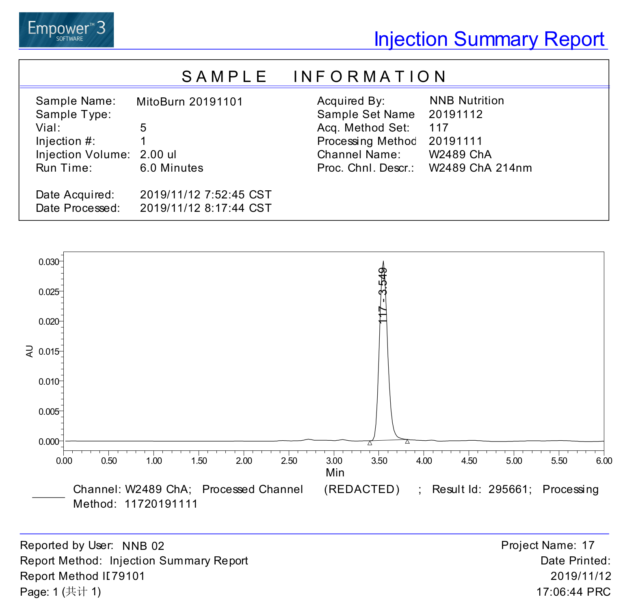
NNB Nutrition provided this HPLC lab test for MitoBurn, with one central peak and no additional "noise" or impurities. Full PDF Available Here
Interested in trying MitoBurn?
Formulators and brands looking to get a sample of BAIBA should check out NNBNutrition.com, email NNB Nutrition directly at info@nnbnutrition.com, or contact us and we will arrange for a test!
BAIBA dosage
The data surrounding the optimal oral dosage of BAIBA in humans is seriously lacking.
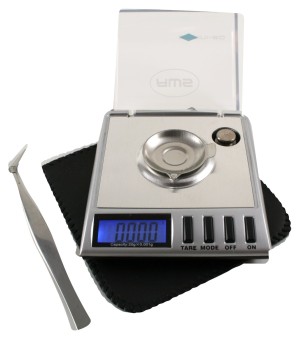
When dealing with powders - especially potent ones, it's critical you use a digital scale that measures down to the milligram.
From the studies performed on mice, we are able to calculate the human equivalent dose which is normalized for body surface area. The successful BAIBA studies done mice equals about 0.016g per kg of bodyweight. For example a 60kg (132lb) human would need roughly 1g/day and a 100kg (220lbs) human would need closer to 1.5g/day.
However, those studies used mixed isomers, while newer data shows that L-BAIBA is the active one. Therefore, when using pure L-BAIBA, we can cut those converted doses in half, leading us to the aforementioned recommended 250-500mg, 1-2x per day.
This is indeed the recommendation from NNB Nutrition, who recommends 250-500mg per serving with 1-2 servings taken per day.
Dosage timing
There is no clinical data testing the timing, but looking at the mechanism, it's clear to see that the two doses should be split apart in the day, with one of the doses used in a pre workout setting.
In the mice trials the BAIBA was given through the drinking water which the mice drank throughout the day.
BAIBA’s Safety Data: Exceptionally High LD50 in Mice
-
What Does LD50 Represent?
Before we dive into L-BAIBA's LD50, we must first have a good understanding of what it means and why it's important. Virtually every supplement or medication has an LD50 which stands for "Lethal Dose 50%" or "median lethal dose". This represents the dosage of a given substance required to kill 50% of the tested population (typically in the context of the subject's body weight). This is crucial for making sure the product is safely dosed, because too much of nearly anything can lead to negative effects.
-
NNB Nutrition’s MitoBurn’s LD50: Greater than 2,000mg/kg!
Late in 2019, NNB Nutrition provided PricePlow with a third-party analysis that assessed the LD50 dosage of L-BAIBA (MitoBurn) in mice.
The data is provided below, but in summary the results show MitoBurn's LD50 is more than 2,000mg/kg of body weight since there were no adverse clinical reactions or mortality experienced at that dose.[29] Based on our recommendations on how much BAIBA you should take per day, 2,000mg/kg is way above that, so this is great safety news.
It's also important to note, that 2000mg/kg was the max dose tested, and even at that insanely high dose, the LD50 still remains unknown in mice.[29] Discovering that L-BAIBA is extremely safe makes us even more comfortable with our suggested dosing.
Heat stability (for use in liquid / “RTD” applications)
For use in "RTD" (ready-to-drink) applications that require pasteurization, MitoBurn has been tested for heat stability. It is currently known to be stable up to 212°F, but note that this is the upper tested limit. If necessary, so greater temperatures can be tested.
Additionally, MitoBurn is stable in carbonated beverages.
Who will benefit from BAIBA use?
There are many types of users who may appreciate BAIBA's effects:
- Dieters with a leptin deficiency who are looking for appetite suppression assistance
- Liberal supplement users who are bulking (or in periods of weight gain) and have an excessive amount of body fat will most likely benefit the most from BAIBA.
- However, it can potentially be used to help those who have a high carbohydrate diet as high carbohydrate diets increase blood triglyceride levels which can interact with VLDL particles and potentially lead to heart disease in the long run.
- People who are unable to exercise due to injury or excess bodyweight / obesity (see your doctor before beginning)
- Keto dieters looking to increase ketone levels
Stacking BAIBA
Truthfully, any new supplement such as this one should first be run 100% standalone in order to assess its efficacy without any confounding variables.
After some use, if there is success and you wish to maintain, the following compounds may provide additional synergy:
-
Yohimbine HCl
Double your MitoBurn L-BAIBA and amplify fat loss on the AstroFlav stack with AstroFlav 2X
Yohimbine is thought to increase noradrenaline and contribute to fat mobilisation in humans. It also inhibits regulatory processes which normally stop fat loss from occurring.[30]
-
Higenamine or Synephrine
Higenamine and Synephrine are beta2 adrenergic receptor agonists that are responsible for the fat loss by increasing cAMP levels in the body. They both follow the same processes which made Ephedrine a huge hit for fat loss,[31] just to a lesser degree.
-
Grains of Paradise
Grains of Paradise is a spice that contains 6-paradol, which has been shown to increase brown fat cells and thus thermogenesis, and may synergize strongly with BAIBA due to its similar effects.
-
Olive Leaf Extract
Research suggests that olive leaf helps reduce lipogenesis and may decrease fat mass in the body. Its effects can be largely contributed to its increase in triiodothyronin and thyroxin, which are thyroid hormones that are important in regulating metabolism.[32]
But once again, any new ingredient should be run standalone first.
Putting it all together
BAIBA works to restore metabolic function and prevent obesity in animal models through several related mechanisms.
-
Attempting to go where no fat burner has gone before
When it comes to weight loss, some products can increase the breakdown of triglycerides into fatty acids. However, if there is no stimulus for them to be used for energy, they are simply reformed back into adipose tissue elsewhere.[21]
This is why it's so important to take most fat burners discussed elsewhere on this site in a pre-workout dosage.
Come on BAIBA Light My Fire[18]
BAIBA, on the other hand, increases the breakdown of triglycerides and then increases the body's metabolic rate through the browning of white fat, which increases the loss of energy as heat, which should allow for released fatty acids to be burned as heat.[1] This is what makes it so exciting.
-
Preventing new fat deposits?
When it comes to preventing fat gain, BAIBA seems to display promising results in mice by preventing the increase of fat tissue in periods of overfeeding.[24]
The mechanism involved is thought to be related to leptin levels, however more research is needed to determine the mechanism behind this.
-
The potential overall health impacts
Finally, when it comes to health, overweight people tend to have higher levels of circulating triglycerides, which are transported through the blood by very low density lipoproteins (VLDL).[33]
These smaller LDL particles are cleared from the blood plasma at a slow rate (increased residence time) where they accumulate in circulation and can penetrate the walls of arteries and cause a response from white blood cells.[33] Triglyceride accumulation can also interact with HDL cholesterol by reducing its residence time and thus decreasing reverse cholesterol transport (the removal of fat away from arteries and cell walls).[33]
This process allows triglyceride-rich LDL particles to spend far too much time in places where they can do serious damage.
There's a possibility that BAIBA may antagonise this process by decreasing LDL and triglyceride levels, and through increasing HDL levels in the body -- but, again, more research is required.[13]
Some Anecdotal Experience: Mike’s BAIBA Review
Listen to Mike discuss his experience with BAIBA, regarding training, heart rate, and more. The long story short? "Half a gear extra", which we always love to take from a non-stimulant ingredient!!
FDA Compliance
The following information is based upon our thorough research, but we are not lawyers. If you are a supplement manufacturer considering using BAIBA and would like further confirmation, please consult your legal team or contact us for DSHEA subject matter experts.
Here is the U.S, dietary supplements definitions and standards are governed under the Dietary Supplement Health and Education Act (DSHEA) passed in 1994.[34]
According to DSHEA, written and passed by Congress, a dietary supplements are defined as any of the following:
- (A) a vitamin;
- (B) a mineral;
- (C) an herb or other botanical;
- (D) an amino acid;
- (E) a dietary substance for use by man/woman to supplement the diet by increasing the total dietary intake; or
- (F) a concentrate, metabolite, constituent, extract, or combination of any ingredient described in clause (A), (B), (C), (D), or (E);
(These clauses are in addition to the fact that the ingredient in question cannot be a scheduled drug, is intended for ingestion, and a few other stipulations.)
Where Does BAIBA Fit Into The DSHEA Standards?
BAIBA (β-Aminoisobutyric Acid) is an amino acid naturally found in both plants and animals, and it's also a metabolite of two amino acids. As you can see from the list above, BAIBA is covered multiple times by DSHEA 1994, in section (D) as well as twice in section (F).
In section (D), BAIBA is covered because it's an amino acid. We also have two more forms of coverage in section (F) crossed with section (D), since BAIBA is a metabolite of two different amino acids in thymine and valine.
BAIBA Has an Additional Foundation in Nature (Botanicals)
BAIBA is found in multiple plants such as theobroma cacao, fabaceae, glycine max, cucurbitaceae, and glycine max,[35] thus it also covers the constituent of a botanical. Which means it crosses sections F and C. However, it's important to note that this information was supplied by the Canada Foundation for Innovation, and they do not cite any peer-reviewed research.
BAIBA is Isolated in Wedgewood Iris
A study published in 1958 titled "Isolation of β-Aminoisobutyric Acid from Bulbs of Iris tingitana var. Wedgewood", stated the researchers were able to extract BAIBA from Wedgewood iris.[36]
This further strengthens the argument that BAIBA is covered as a botanical, since Wedgewood Iris is a plant.
After summing together all the evidence, we're confident that L-BAIBA (MitoBurn) is in fact classified as a dietary supplement. This is great news, because this naturally-occurring amino acid can provide a host of benefits when added to a sound diet, which is the exact purpose of a supplement!
Conclusion: "BAIBA, when I think about you..."
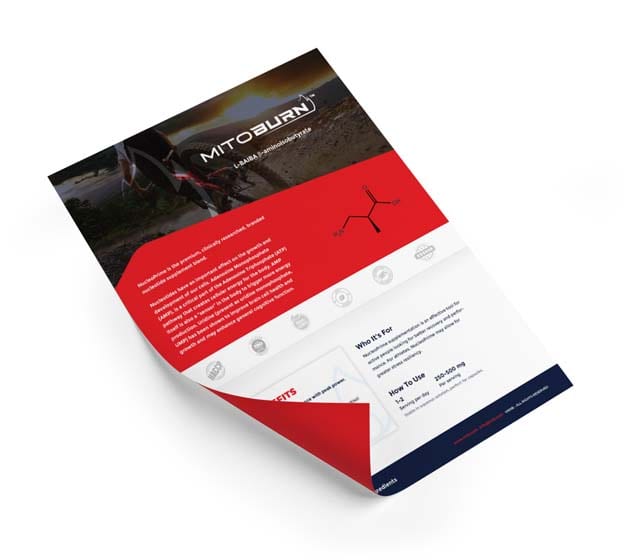
Interested in trying MitoBurn from NNB? Contact us and we'll arrange a sample for your brand!
This article was originally written in 2015, when we were very excited about it, but there have been sourcing issues that made it next to impossible to find. Four years later, we came back to update the article and found a trusted and tested supplier in NNB Nutrition who has the ingredient, and came to realize that there was even more research behind the ingredient.
Meanwhile, the diet world seems to have caught up with the effects of BAIBA, given that ultra low carb ketogenic diets have exploded during this timeframe, and this is an extremely pro-ketogenic supplement.
At the end of the day, we're definitely more confident that BAIBA is a potential Next Big Thing, but still want to see human research before we can 100% get on board. With that said, we're always excited about new compounds and new products, and as time has passed since our original publication, we've grown far more interested in the ingredient.
Subscribe to PricePlow's Newsletter and Alerts on These Topics

Interested in trying NNB Nutrition's MitoBurn for your brand's formulas? Contact us and we'll arrange a sample for you!
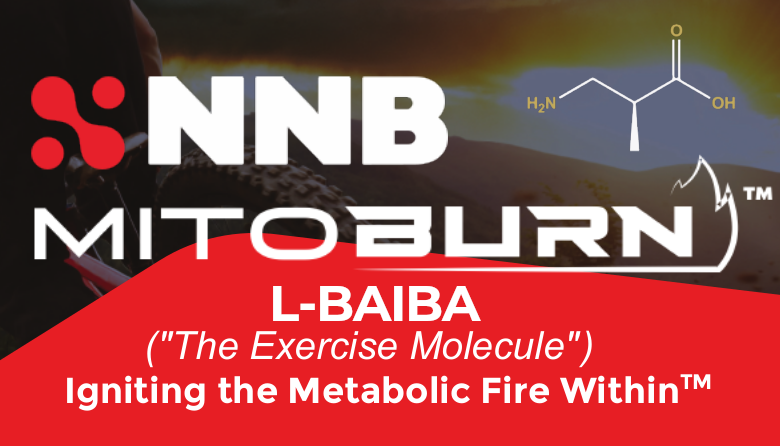
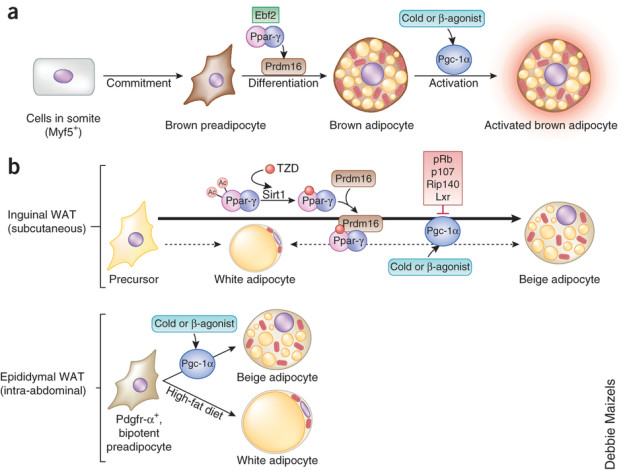







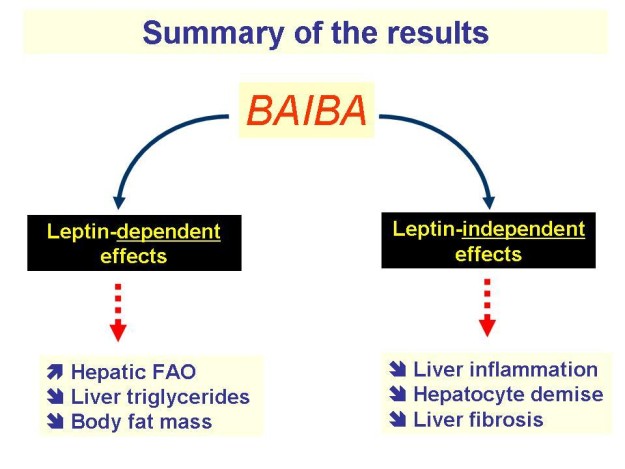


Comments and Discussion (Powered by the PricePlow Forum)